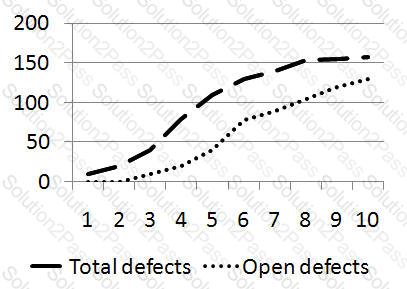CTFL-001 iSQI ISTQB Certified Tester Foundation Level Free Practice Exam Questions (2025 Updated)
Prepare effectively for your iSQI CTFL-001 ISTQB Certified Tester Foundation Level certification with our extensive collection of free, high-quality practice questions. Each question is designed to mirror the actual exam format and objectives, complete with comprehensive answers and detailed explanations. Our materials are regularly updated for 2025, ensuring you have the most current resources to build confidence and succeed on your first attempt.
During test process improvement it is recommended to use standards where possible. Standards originate from various sources and they cover different subjects in relation to testing Pick TWO sources of software standards, useful to software testing from the ones mentioned below. 1 credit
Which of the following phases in the fundamental test process is considered to deliver a document which can be used as a major input for test process improvement? 1 credit
Which of the following would you NOT expect to see on an incident report from test execution?
Why is measurement of code coverage Important?
Which of the following options describe the causal chain in the correct sequence?
Since the system is in the medical domain and therefore in the safety critical area, testing needs to be rigorous and evidence is required that the system has been adequately tested. Identify THREE measures that would typically be part of the test approach in this domain and which are not always applicable in other domains! 1 credit
You have been given responsibility for the non-functional testing of a safety-critical monitoring & diagnostics package in the medical area. Which of the following would you least expect to see addressed in the test plan? 1 credit
Consider the typical objectives of testing. Which of the following metrics can be used to measure the effectiveness of the testing process in achieving one of those objectives? 1 credit
Considerable attention will be given in this project to defining exit criteria and on reporting back on their status. Which combination of TWO exit criteria from the list would be best to use? 1 credit
I. Total number of defects found
II. Percentage of test cases executed
III. Total test effort planned versus total actual test effort spent
IV. Defect trend (number of defects found per test run over time
A test log is one of the documents that need to be produced in this domain in order to provide evidence of testing. However, the level of detail of test logs can vary. Which of the following is NOT an influencing factor for the level of detail of the test logs being produced? 1 credit
Continuing with the Scenario described in the previous question, which of the following topics would you need to address in detail in the master test plan? 3 credits
Given is the following defect removal chart reported at the end of system testing - showing total defects detected and closed defects (fixed and successfully retested). A number of open defects are classified as critical. All tests have been executed.

Based on the chart above, what is the most appropriate next test phase? 1 credit
Relying only on the information provided in the scenario, select the TWO items and/or features for which sufficient information is available to proceed with test design. 2 credits
Given the following figures for the testing on a project, and assuming the failure rate for initial tests remains constant and that all retests pass, what number of tests remain to be run? 3 credits

What would be a test approach regarding the test design techniques to be applied that would fit an item with the highest risk? 2 credits
Evaluate the status of the project against the defined exit criteria. Which of the following options shows the correct status? 2 credits
As part of the test strategy, entry and exit criteria will be defined for each test level. Which is NOT a valid reason for using entry and exit criteria? 1 credit
Which THREE activities would be valid steps during the development of the test strategy?2 credits (2 out of 3 correct 1 credit)
Within the projects, a master test plan and phase test plan will be used. Following is a list of characteristics applicable for test plans:
a. Any deviation from the procedures described in the test
b. strategy document
c. The overall estimated costs, timescales and resource
d. requirements
e. A detailed schedule of testing activities
f. The development deliverables to be tested
g. Which test staff members (names) will be involved and when
h. Level of requirements coverage achieved
Which TWO of the above mentioned characteristics relate to the phase test plan? 1 credit
Within the projects, a master test plan and phase test plan will be used. Following is a list of characteristics applicable for test plans:
a. Any deviation from the procedures described in the test strategy document
b. The overall estimated costs, timescales and resource requirements
c. A detailed schedule of testing activities
d. The development deliverables to be tested
e. Which test staff members (names) will be involved and when
f. Level of requirements coverage achieved
Which THREE of the above mentioned characteristics relate to the master test plan? 1 credit
